 |
Cypress St. Looking North By Walnut St., December, 1915
Trolley tracks are on Cypress, Walnut St. feeds in from the left. On the left is the house of the Francis family at 295 Walnut. On the right is 161 Cypress. Center rear are the back of houses on E. Milton Rd.
[Source: Olmsted]
|
 |
Chestnut St., November 1915
Looking southeast toward Kendall St. #60, foreground left, is still standing along with the others on that side.Only the stone fence remains on the right side.
[Source: Olmsted]
|
 |
Construction of the Second Unitarian Society Parish House, Sewall Ave., circa 1901
The Society formed in 1896 and initially met in the Sears Chapel on Colchester St. They constructed this building, at today’s 50 Sewall Ave., and began holding services there in early 1902. Visible on the right is the S. S. Pierce building and, on the left in the far distance, the Etsy mansion on top of Aspinwall Hill. In 1916, the congregation moved to a new building next door at 11 Charles St.
[Source: Smithsonian]
|
 |
29 Colchester St., 1910
Built in 1903-04 by Edward Boit, and designed by Peabody & Stearns
[Source: Smithsonian]
|
 |
6 Hawes St., November, 1910
Built in 1864 for David Sears; was remodeled and expanded in 1906 by Clarence H. Blackall for Nathaniel Amster, a mining expert
[Source: Smithsonian]
|
 |
16 Hawes St., November, 1910
Designed by architects P. B. Howard and Charles E. Patch; built in 1906 for Clara and H. A. Gowing. All houses in the photo still stand. 1090-1100 Beacon St. is in the far distance.
[Source: Smithsonian]
|
 |
10 Hawes Pl., November, 1910
The George Quincy House, built in 1909, on the corner of Hawes Place and Borland Street.
[Source: Smithsonian]
|
 |
26 Beech Rd., 1910
Designed in 1907 by Hartwell, Richardson & Driver for Joseph Gahm.
[Source: Smithsonian]
|
 |
Looking East From Longwood Ave. Bridge, 1907
Boston in the distance. From left to center: Sears Chapel, Chapel St., Boston & Albany railroad tracks, walking paths on either side of the Muddy River.
|
 |
Looking East From Longwood Ave. Bridge, 1907
From left to center: Sears Chapel, Chapel St.,Longwood Station of Boston & Albany Railroad, the Muddy River.
|
 |
Longwood Station, Boston & Albany Railroad, 1907
|
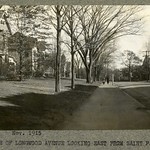 |
Longwood Ave., November 1915
Looking east from St. Paul St., #86 is on the immediate left. Visible houses are no longer standing.
[Source: Olmsted]
|
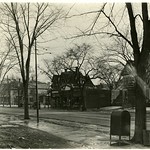 |
Harvard St. Across From Naples Rd.
Looking southeast from Fuller St. toward Coolidge Corner. Right: 406 Harvard St., no longer stands. Center: 402 Harvard St., the 3-store brick building still stands today as part of a longer row of stores. Note Krotki's Pharmacy.
[Source: Olmsted]
|
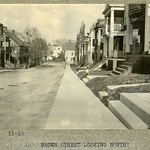 |
Browne St., November 1915
Looking north toward Freeman St.
[Source: Olmsted]
|
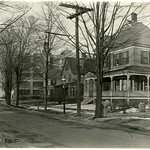 |
217, 227, 231 Babcock St., February 1921
Looking from Winslow to the Brighton border at Commonwealth Ave. Only the factory building remains.
[Source: Olmsted]
|
 |
Babcock St., November 1915
Looking north from John St. Houses foreground right are no longer standing. Apartment building at 69-71 Babcock St just before Dwight St. and the house across the street at 80 Babcock St. remain.
[Source: Olmsted]
|
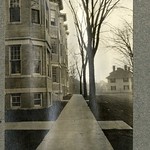 |
62 Dwight St., November 1915
Looking toward Babcock St. House on Babcock no longer standing.
[Source: Olmsted]
|
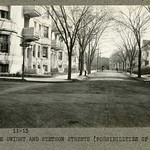 |
Dwight St., November 1915
Looking southest from Stetson St. toward Pleasant St. 31 - 45 Dwight St. apartments on the left. Houses on the right no longer standing. Note cyclist on the right.
[Source: Olmsted]
|
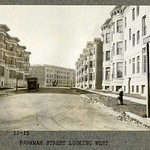 |
Parkman St., November 1915
Looking west from Powell St.
[Source: Olmsted]
|
 |
19 Powell St., November 1910
Built in 1904 and designed by Loring & Phipps. Still standing.
[Source: Smithsonian]
|